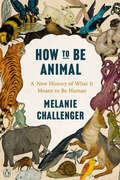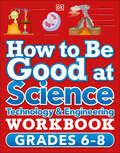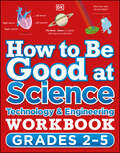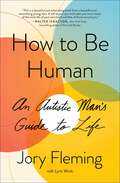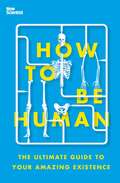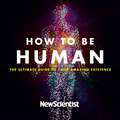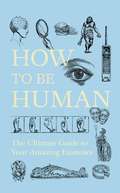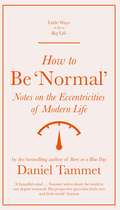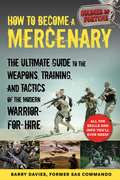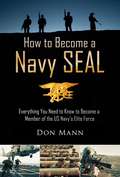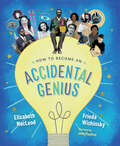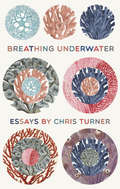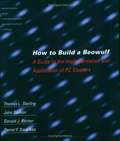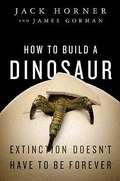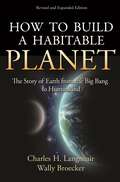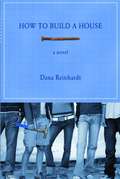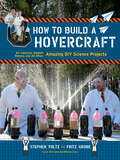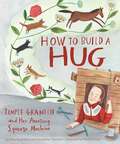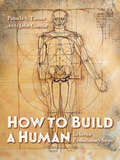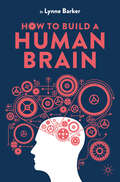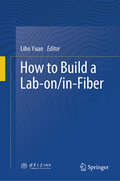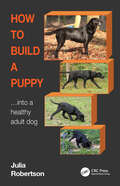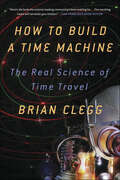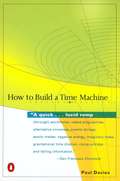- Table View
- List View
How to Be Animal: A New History of What It Means to Be Human
by Melanie Challenger&“A brilliant, thought-provoking book.&” —Matt Haig, New York Times bestselling author of The Midnight Library A wide-ranging take on why humans have a troubled relationship with being an animal, and why we need a better oneHuman are the most inquisitive, emotional, imaginative, aggressive, and baffling animals on the planet. But we are also an animal that does not think it is an animal. How well do we really know ourselves?How to Be Animal tells a remarkable story of what it means to be human and argues that at the heart of our existence is a profound struggle with being animal. We possess a psychology that seeks separation between humanity and the rest of nature, and we have invented grand ideologies to magnify this. As well as piecing together the mystery of how this mindset evolved, Challenger's book examines the wide-reaching ways in which it affects our lives, from our politics to the way we distance ourselves from other species. We travel from the origin of homo sapiens through the agrarian and industrial revolutions, the age of the internet, and on to the futures of AI and human-machine interface. Challenger examines how technology influences our sense of our own animal nature and our relationship with other species with whom we share this fragile planet.That we are separated from our own animality is a delusion, according to Challenger. Blending nature writing, history, and moral philosophy, How to Be Animal is both a fascinating reappraisal of what it means to be human, and a robust defense of what it means to be an animal.
How to Be Good at Science, Technology and Engineering Workbook, Grade 6-8 (DK How to Be Good at)
by DKGain a complete understanding of Grades 6, 7 and 8 STEM subjects.From atoms and rocketships to vaccines and the human nervous system, this fully illustrated home learning workbook will help your child be at the top of their science class!This engaging science book for kids makes tricky topics and challenging concepts completely crystal clear! Here&’s what&’s inside: • Covers the core STEM topics, from biology, chemistry and physics, to technology. • Clearly laid out with easy-to-follow instructions for children to use by themselves. • Answers are given at the back of the book. • Practice questions and practical exercises to help expand your child&’s knowledge of the subject. Take your child&’s STEM learning to the next levelDid you know that many plants have a transport system to carry water and nutrients wherever they are needed? Or that most power stations around the world burn fossil fuels to make electricity? Packed with fascinating facts, fun graphics and step-by-step explanations, this brilliant visual workbook makes understanding science, technology and engineering super simple! It&’s perfect for extra science revision practice before an important test. Perfect for children ages 11-14, this colorful science practice book covers all the key areas of the school curriculum for this level. It includes genes and DNA, molecules, chemical reactions, the periodic table, heat transfer, electricity and magnetism, seasons and climate zones, and lots more. And there are answers at the back to check that you're on the right path.This engaging and clear science workbook accompanies How to be Good at Science, Technology, and Engineering Grade 2-5 which covers ages 7-11 (Grades 2, 3, 4 and 5).Discover How to be Good at other subjectsDK&’s successful How to be Good at... workbook series provides your child with the tools to learn how to look at the world around them and figure out how it works. There are more books to discover! Learn everything they need to know about math through eye-catching illustrations and easy-to-follow instructions with How to Be Good at Math.
How to Be Good at Science, Technology and Engineering Workbook, Grades 2-5 (DK How to Be Good at)
by DKHelp your child master Grade 2 to 5 STEM subjects and become a science superstar!From learning how the heart works to understanding what evolution is, this fully illustrated home learning workbook makes grasping science, technology and engineering as easy as ABC.This engaging science book for kids makes tricky topics and challenging concepts completely crystal clear! Here&’s what&’s inside: • Covers the core STEM topics for grades 2-5, from biology, chemistry and physics to technology. • Clearly laid out with easy-to-follow instructions for children to use by themselves. • Answers are given at the back of the book. • Practice questions and practical exercises to help expand your child&’s knowledge of the subject. Inspire your child with scienceDid you know that the human skeleton is made up of 206 bones? Or that the Earth&’s human population has quadrupled in the last hundred years? Packed with fascinating facts, fun graphics and step-by-step explanations, this brilliant visual workbook will keep budding scientists and engineers engaged. It helps kids understand what they&’ve learned in school and gives them extra science revision practice before an important test. Perfect for children ages 7-11, this colorful science practice book covers all the key areas of the school curriculum for this level. It includes the human body, animal and plant life, evolution, states of matter, energy, simple mechanics, the Earth, Moon and Sun, and lots more. And there are answers at the back to check that you&’re on the right path.This engaging and clear science workbook accompanies How to be Good at Science, Technology, and Engineering Grade 5-8 which covers ages 11-14 (Grades 5, 6, 7 and 8).Discover How to be Good in other subjectsDK&’s successful How to be Good at... workbook series provides your child with the tools to learn how to look at the world around them and figure out how it works. There are more books to discover! Learn everything they need to know about math through eye-catching illustrations and easy-to-follow instructions with How to Be Good at Math.
How to Be Human: An Autistic Man's Guide to Life
by Jory FlemingA &“beautiful and astonishing&” (Walter Isaacson, # 1 New York Times bestselling author of The Code Breaker) narrative that examines the many ways to be fully human, told by the first young adult with autism to attend Oxford University as a Rhodes Scholar. As a child, Jory Fleming was wracked by uncontrollable tantrums, had no tolerance for people, and couldn&’t manage the outside world. Slightly more than a decade later, he was bound for England, selected to attend one of the world&’s premier universities. How to Be Human is a &“profound, thought-provoking&” (Barry M. Pizant, PhD, author of Uniquely Human) exploration of life amid a world constructed for neurotypical brains when yours is not. But the miracle of this book is that instead of dwelling on Jory&’s limitations, those who inhabit the neurotypical world will begin to better understand their own: they will contemplate what language cannot say, how linear thinking leads to dead ends, and how nefarious emotions can be, particularly when, in Jory&’s words, they are &“weaponized.&” Through a series of deep, personal conversations with writer Lyric Winik, Jory makes a compelling case for logical empathy based on rational thought, asks why we tolerate friends who see us as a means to an end, and explains why he believes personality is a choice. Most movingly, he discusses how, after many hardships, he maintains a deep, abiding faith: &“With people, I don&’t understand what goes in and what comes out, and how to relate,&” he says. &“But I can always reconnect with my relationship with my Creator.&” Join Jory and Lyric as they examine what it means to be human and ultimately how each of us might become a better one. Jory asks us to consider: Who has value? What is a disability? And how do we correct the imbalances we see in the world? How to Be Human shows us the ways a beautifully different mind can express the very best of our shared humanity.
How to Be Human: The Ultimate Guide to Your Amazing Existence
by New ScientistIf you thought you knew who you were, THINK AGAIN.Did you know that half your DNA isn't human? That somebody, somewhere has exactly the same face? Or that most of your memories are fiction?What about the fact that you are as hairy as a chimpanzee, various parts of your body don't belong to you, or that you can read other people's minds? Do you really know why you blush, yawn and cry? Why 90 per cent of laughter has nothing to do with humour? Or what will happen to your mind after you die?You belong to a unique, fascinating and often misunderstood species. How to be Human is your guide to making the most of it.
How to Be Human: The Ultimate Guide to Your Amazing Existence
by New ScientistIf you thought you knew who you were, THINK AGAIN.Did you know that half your DNA isn't human? That somebody, somewhere has exactly the same face? Or that most of your memories are fiction?What about the fact that you are as hairy as a chimpanzee, various parts of your body don't belong to you, or that you can read other people's minds? Do you really know why you blush, yawn and cry? Why 90 per cent of laughter has nothing to do with humour? Or what will happen to your mind after you die? You belong to a unique, fascinating and often misunderstood species. How to be Human is your guide to making the most of it.
How to be Human: Consciousness, Language and 48 More Things that Make You You
by New ScientistWhat is it that makes us human? Is it language, imagination, morality, or is it that we cook and wear shoes? Or perhaps we are less human than we think (Neanderthal and Denisovan genes can be found within all of us!). Once again, New Scientist have all of the fascinating and unexpected answers, and - just as they did for the universe in The Origin of (almost) Everything - in How to be Human they take us on a tour around the human body and brain, taking in everything from evolution to email, from the Stone Age to Spotify. How do languages change the way our brains are wired? What can evolutionary theory tell us about who we are attracted to? How does your voice give away clues about your political views, your sexual allure and even your salary? Why is gossip the human version of a gorilla picking fleas from its mate? And how can you live to 100? From the body to language, through emotions and possessions, to the five things that make all of us unique (it isn't just fingerprints), New Scientist's witty essays sit alongside enlightening illustrations that range from how your brain creates the illusion of 'self' to the allure of body odor.
How to Be 'Normal': Notes on the eccentricities of modern life (Little Ways to Live a Big Life #5)
by Daniel TammetAn eye-opening short book by the international bestselling writer of Born on a Blue Day and Thinking in Numbers.Have you ever wondered how neurotypicals - so called 'normal' people - come across to those who are on the autistic spectrum? What would an instruction manual about being an average human being look like to them? And actually, would it be that different, fundamentally, to a field guide about autistic people (were such a thing to exist)?Daniel Tammet is an essayist, poet, novelist and translator. In 2004, he was diagnosed with high-functioning autistic savant syndrome. In this eye-opening and fascinating book, he takes readers on a tour around nightclubs, ponders the significance of tattoos, delves into anti-age creams and puzzles over playing the lottery, all from the perspective of someone who approaches everything in life from a unique angle. After all, this is a man for whom Wednesdays are always blue, who sees numbers as shapes and who learned conversational Icelandic from scratch in seven days.These short essays come together in a beautifully written, sometimes humorous but always refreshing narrative that focuses on the eccentricities of modern life as seen through the eyes of someone always on the outside. Rather wonderfully, it illustrates the eccentricity inherent in every kind of mind, reminding us of the little-noticed strangeness of our common humanity, while subtly questioning what it means to be thought 'normal'.
How to Be 'Normal': Notes on the eccentricities of modern life
by Daniel TammetAn eye-opening short book by the international bestselling writer of Born on a Blue Day and Thinking in Numbers.Have you ever wondered how neurotypicals - so called 'normal' people - come across to those who are on the autistic spectrum? What would an instruction manual about being an average human being look like to them? And actually, would it be that different, fundamentally, to a field guide about autistic people (were such a thing to exist)?Daniel Tammet is an essayist, poet, novelist and translator. In 2004, he was diagnosed with high-functioning autistic savant syndrome. In this eye-opening and fascinating book, he takes readers on a tour around nightclubs, ponders the significance of tattoos, delves into anti-age creams and puzzles over playing the lottery, all from the perspective of someone who approaches everything in life from a unique angle. After all, this is a man for whom Wednesdays are always blue, who sees numbers as shapes and who learned conversational Icelandic from scratch in seven days.These short essays come together in a beautifully written, sometimes humorous but always refreshing narrative that focuses on the eccentricities of modern life as seen through the eyes of someone always on the outside. Rather wonderfully, it illustrates the eccentricity inherent in every kind of mind, reminding us of the little-noticed strangeness of our common humanity, while subtly questioning what it means to be thought 'normal'.
How to Become a Mercenary: The Ultimate Guide to the Weapons, Training, and Tactics of the Modern Warrior-for-Hire
by Barry DaviesFor anyone who's ever considered a career as a warrior-for-hire—or who just wants to learn more about the lifestyle—How to Become a Mercenary is the ultimate guide to all the history, training, and equipment information you'll ever need! Mercenaries—who are often trained as part of the best Special Forces, including American Delta Force, British SAS, French Foreign Legion, Marines, SBS, SEALs, and many others—perform one of the most dangerous and feared jobs in the world. Their task is to go into remote locations and remove their targets by any means necessary. They are &“hired hands,&” and have no remorse for their actions. Now, along with Soldier of Fortune magazine, Barry Davies teaches you the training and knowledge that goes into being a mercenary, as well as the history of the profession and how it has evolved. How to Become a Mercenary will teach you everything you&’ve ever needed to know about becoming a mercenary, and also how to excel at it with information on weapons, escape plans, and overall safety. You will learn: • Where and how to find work • How to understand and apply the most modern tactics • What languages to master • Which weapons are preferred • How to disappear after you&’ve completed your job It&’s always been about the money, but in this book, you will learn all the skills that you must acquire before you take your first job. Just remember: Article 47 of the Geneva Convention states that &“a mercenary shall not have the right to be a combatant or a prisoner of war.&” Getting caught is not an option, and in this manual, you will learn how to avoid that at all costs.
How to Become a Navy SEAL: Everything You Need to Know to Become a Member of the US Navy's Elite Force
by Don MannDo you want to be a member of one of the world's most elite special operations forces? Not everyone has what it takes to become a Navy SEAL (Sea, Air, and Land). The training required--and the job itself--is exhausting and demanding, but also exhilarating and highly respected. If you or someone you know is up for the challenge, this book has everything you need to know, from schooling and training to pay range, placement, qualifications, and what you can expect after you become a SEAL. To become a SEAL in the Naval Special Warfare/Naval Special Operations (NSW/NSO) community, you must first go through what is often considered to be the most physically and mentally demanding military training in the world. With this book, you can prepare yourself by learning what to expect before taking on the ruthless and rewarding job of defending your country against foes around the world. This guide includes advice from current and former Navy SEALs on direct action warfare, special reconnaissance, counterterrorism, and foreign internal defense. When there's nowhere else to turn, Navy SEALs are in their element. They achieve the impossible by way of conditioned response, sheer willpower, and absolute dedication to their training, their missions and their fellow special ops team members.
How to Become an Accidental Genius (Accidental Series #1)
by Frieda Wishinsky Elizabeth MacLeodDon't be afraid to try! Make connections! Be persistent! Ask questions and never take no for an answer! Learn the secrets and amazing stories of successful inventors! <P><P>How to Become an Accidental Genius is full of inspiring tales of famous and lesser-known inventors who have changed the world, from George Washington Carver, Mary Anderson (inventor of the windshield wiper) and inventor and actress Hedy Lamarr to Frank Epperson (of Popsicle fame) and Mary Sherman Morgan (The Woman Who Saved the U.S. Space Race). Readers will be amazed at the inventiveness of these geniuses. The book focuses on inventors from North America but includes stories from around the world. Organized into eleven chapters that highlight the qualities inventors have in common, the book also features profiles of inventive kids and teenagers.
How to Breathe Underwater
by Chris TurnerThe essays and reportage in How to Breathe Underwater offer a panoramic overview of this age of radical change-from the online gambling boom in the Caribbean to Cyberjaya, the Malaysian government's attempt to build its own Silicon Valley; from video game design to digital-age tabloid journalism to the artistry of The Simpsons; and from the fate of the Great Barrier Reef to Cuba's economic limbo after the fall of the Soviet empire. In field reports that survey the rise of the internet in the 1990s, analyze the changing nature of mass culture in the digital age, and provide a multifaceted look at how human industry is shaping the planet's foundations, this collection presents a fractal portrait of a society in rapid flux. Chris Turner is the author of four previous books, a nine-time National Magazine Award winner and a sought-after speaker on the rise of the global green economy, as well as a celebrated feature writer for The Walrus, Canadian Geographic, The Globe & Mail and other major publications. His lively and passionate reportage, along with his incisive essays and shrewd cultural criticism, have for the past fifteen years made essential contributions to the debates on our climate, culture, and technology. They are collected here for the first time.Praise for How To Breathe Underwater"Chris Turner is among the best magazine writers on the planet. His writing is so beautiful, wry and well-reported that it's spellbinding. And spellbreaking: He wakes you up, makes you sit upright and look afresh at our culture, our climate, and where we need to go. This is literary nonfiction at its finest."-Clive Thompson, Wired columnist and author of Smarter Than You Think"Chris Turner is the master of long-form journalism in Canada, a smart, funny, and endlessly curious envoy to everywhere. This collection gathers his best work, forging links of meaning in a chain of superb reporting and writing; readers will see many choice pieces and realize, maybe for the first time, that they were all fashioned by the same indefatigable intelligence."-Mark Kingwell, the author of A Civil Tongue"Whatever you choose to call this kind of stylishly reported, deeply engaged, richly nuanced, gorgeously written nonfiction--saturation reportage, new journalism, longform writing--it without question qualifies as real literature. It's the only kind of journalism that gets remembered, and the only kind that produces real change. Chris Turner has been writing it since he started taking notes."-Ian Brown, author of The Boy in the Moon and Globe & Mail feature writer
How to Build a Beowulf: A Guide to the Implementation and Application of PC Clusters
by Thomas L. Sterling John Salmon Donald J. Becker Daniel F. SavareseSupercomputing research--the goal of which is to make computers that are ever faster and more powerful--has been at the cutting edge of computer technology since the early 1960s. Until recently, research cost in the millions of dollars, and many of the companies that originally made supercomputers are now out of business. The early supercomputers used distributed computing and parallel processing to link processors together in a single machine, often called a mainframe. Exploiting the same technology, researchers are now using off-the-shelf PCs to produce computers with supercomputer performance. It is now possible to make a supercomputer for less than $40,000. Given this new affordability, a number of universities and research laboratories are experimenting with installing such Beowulf-type systems in their facilities. This how-to guide provides step-by-step instructions for building a Beowulf-type computer, including the physical elements that make up a clustered PC computing system, the software required (most of which is freely available), and insights on how to organize the code to exploit parallelism. The book also includes a list of potential pitfalls.
How to Build a Dinosaur
by Jack Horner James GormanA world-renowned paleontologist reveals groundbreaking science that trumps science fiction: how to grow a living dinosaur Over a decade after Jurassic Park, Jack Horner and his colleagues in molecular biology labs are in the process of building the technology to create a real dinosaur. Based on new research in evolutionary developmental biology on how a few select cells grow to create arms, legs, eyes, and brains that function together, Jack Horner takes the science a step further in a plan to "reverse evolution" and reveals the awesome, even frightening, power being acquired to recreate the prehistoric past. The key is the dinosaur's genetic code that lives on in modern birds- even chickens. From cutting-edge biology labs to field digs underneath the Montana sun, How to Build a Dinosaur explains and enlightens an awesome new science.
How to Build a Habitable Planet: The Story of Earth from the Big Bang to Humankind - Revised and Expanded Edition
by Charles H. Langmuir Wallace BroeckerA classic introduction to the story of Earth's origin and evolution—revised and expanded for the twenty-first centurySince its first publication more than twenty-five years ago, How to Build a Habitable Planet has established a legendary reputation as an accessible yet scientifically impeccable introduction to the origin and evolution of Earth, from the Big Bang through the rise of human civilization. This classic account of how our habitable planet was assembled from the stuff of stars introduced readers to planetary, Earth, and climate science by way of a fascinating narrative. Now this great book has been made even better. Harvard geochemist Charles Langmuir has worked closely with the original author, Wally Broecker, one of the world's leading Earth scientists, to revise and expand the book for a new generation of readers for whom active planetary stewardship is becoming imperative.Interweaving physics, astronomy, chemistry, geology, and biology, this sweeping account tells Earth’s complete story, from the synthesis of chemical elements in stars, to the formation of the Solar System, to the evolution of a habitable climate on Earth, to the origin of life and humankind. The book also addresses the search for other habitable worlds in the Milky Way and contemplates whether Earth will remain habitable as our influence on global climate grows. It concludes by considering the ways in which humankind can sustain Earth’s habitability and perhaps even participate in further planetary evolution.Like no other book, How to Build a Habitable Planet provides an understanding of Earth in its broadest context, as well as a greater appreciation of its possibly rare ability to sustain life over geologic time.Leading schools that have ordered, recommended for reading, or adopted this book for course use:Arizona State UniversityBrooklyn College CUNYColumbia UniversityCornell UniversityETH ZurichGeorgia Institute of TechnologyHarvard UniversityJohns Hopkins UniversityLuther CollegeNorthwestern UniversityOhio State UniversityOxford Brookes UniversityPan American UniversityRutgers UniversityState University of New York at BinghamtonTexas A&M UniversityTrinity College DublinUniversity of BristolUniversity of California-Los AngelesUniversity of CambridgeUniversity Of ChicagoUniversity of Colorado at BoulderUniversity of GlasgowUniversity of LeicesterUniversity of Maine, FarmingtonUniversity of MichiganUniversity of North Carolina at Chapel HillUniversity of North GeorgiaUniversity of NottinghamUniversity of OregonUniversity of OxfordUniversity of PortsmouthUniversity of SouthamptonUniversity of UlsterUniversity of VictoriaUniversity of WyomingWestern Kentucky UniversityYale University
How to Build a House
by Dana ReinhardtHarper's dad is getting a divorce from her beloved stepmother, Jane. Even worse, Harper has lost her stepsister, Tess; the divorce divides them. Harper decides to escape by joining a volunteer program to build a house for a family in Tennessee who lost their home in a tornado. Not that she knows a thing about construction. Soon she's living in a funky motel and working long days in blazing heat with a group of kids from all over the country. At the site, she works alongside Teddy, the son of the family for whom they are building the house. Their partnership turns into a summer romance, complete with power tools. Learning to trust and love Teddy isn't easy for Harper, but it's the first step toward finding her way back home.
How to Build a Hovercraft: Air Cannons, Magnetic Motos, and 25 Other Amazing DIY Science Projects
by Stephen Voltz Fritz GrobeWith this fun yet informative guide for all skill levels, create extraordinary science experiments you can do at home using everyday objects. From the Coke and Mentos fountain makers who found initial fame via Maker Faire and YouTube (more than 150 million views!) comes this collection of DIY science projects guaranteed to inspire a love of experimentation. Fritz Grobe and Stephen Voltz, also known as EepyBird, share their favorite projects: a giant air vortex cannon, a leaf blower hovercraft, a paper airplane that will fly forever, and many more. Each experiment features instructions that will take users from amateur to showman level—there&’s something here for all skill levels—alongside illustrations, photographs, and carefully explained science. How to Build a Hovercraft is guaranteed to engage curious minds and create brag-worthy results! Caution: Many of these experiments require adult supervision, and some of them should not be performed by children at all. Praise for How to Build a Hovercraft &“Want to create big, splashy projects mostly using household items? This fun book contains detailed step-by-step instructions, well-thought-out scientific explanations, and sensible safety precautions.&” —Natural History, Holiday Gift Guide Pick
How to Build a Hug: Temple Grandin And Her Amazing Squeeze Machine
by Amy GuglielmoAmy Guglielmo, Jacqueline Tourville, and Giselle Potter come together to tell the inspiring story of autism advocate Dr. Temple Grandin and her brilliant invention: the hug machine. <P><P> As a young girl, Temple Grandin loved folding paper kites, making obstacle courses, and building lean-tos. But she really didn’t like hugs. Temple wanted to be held—but to her, hugs felt like being stuffed inside the scratchiest sock in the world; like a tidal wave of dentist drills, sandpaper, and awful cologne, coming at her all at once. Would she ever get to enjoy the comfort of a hug? <P><P> Then one day, Temple had an idea. If she couldn’t receive a hug, she would make one…she would build a hug machine!
How to Build a Human: In Seven Evolutionary Steps
by Pamela S. TurnerThe epic story of our evolution in seven big steps!How did we become who we are? With trademark wit, acclaimed science writer Pamela S. Turner breaks down human evolution into the seven most important steps leading to Homo sapiens. How, when, and why did we:1. stand up,2. smash rocks,3. get swelled heads,4. take a hike,5. invent barbecue,6. start talking (and never shut up), and 7. become storytellers?This fascinating, wickedly funny account of our evolutionary journey turns science into an irresistible story. Vetted by experts at the Smithsonian's Human Origins Program, the book also features incredibly detailed portraits by celebrated paleo-artist John Gurche that bring our early ancestors to life.
How to Build a Human Brain
by Lynne BarkerHow to Build a Human Brain takes a developmental approach to understanding brain structure and function. It guides readers through the evolution of the human brain, from its cellular building blocks, up to hind brain structures and functions, and through to neocortex and associated functions. In doing so, it enables students to develop a comprehensive knowledge of the relationship between brain networks and functions, neural underpinnings of functional problems seen after neuropathology, and neuroanatomy.Written in an engaging style, each chapter follows a blueprint format with subsections on issues like 'damage and repair' and 'faulty wiring' as the brain is ‘built’ across the course of the book. The author includes illustrative case studies and entertaining fast fact boxes to highlight the real-word relevance of each brain structure being examined. This textbook offers an accessible reference for students of neuroscience, cognitive neuroscience, neuropsychology,and biological psychology.
How to Build a Lab-on/in-Fiber
by Libo YuanThis book explores the technical foundations of constructing diverse laboratories on optical fiber. In recent years, microstructured-based optical fiber devices and sensors have emerged as a rapidly advancing area within the field of optical fiber sensing technology. The concept of creating a laboratory on optical fiber has been inspired by advances in micro-structured fiber optics. Given the natural existence of optical waveguide channels within fibers, it is feasible to integrate a wide range of materials such as inorganic, organic, biological, and nonlinear optical substances—into or onto the fiber's end face or side. This integration facilitates the interaction between light and matter, leading to measurable optical outcomes through the fiber's optical channel. The rapid evolution of this concept is driven by the ease with which strong interactions can be achieved between light and matter at the micro-nano scale within the fiber, making it an ideal platform for experiments in lightwave microscale physics, photochemistry, and the interaction between light and both biological and microbial materials. The fiber optics laboratory thus offers a compelling stage for interdisciplinary research endeavors. This book serves as a comprehensive and systematic introduction to the core techniques involved in establishing various laboratories on fiber, complemented by practical examples that illustrate the purpose, methodology, and technical approaches to developing fiber-based laboratories. It stands as an invaluable reference for students and researchers intrigued by the cutting-edge advancements in fiber optic technology.
How to Build a Puppy: Into a Healthy Adult Dog
by Julia RobertsonDogs do not demonstrate discomfort or pain in a way that can be easily translated by us humans, so we often miss that they are physically struggling. Understanding that making some very simple changes to our homes, activities, exercise regimes and how we train our puppies will have a massive positive impact on our dogs' lives. Using her world-renowned Galen Myotherapy knowledge and approach, Robertson suggests and explains in detail how small, profoundly important but easy to implement changes can improve the way we not only look after and develop our puppies but also how maintenance of this easy programme continues your puppy’s journey through into healthy adolescence and maturity. Environment, exercise and activity habits have deep, ongoing effects and How to Build a Puppy ... into a healthy adult dog explores ways in which positive change can be integrated easily into our normal lives. The book culminates into a full programme called the Galen Myotherapy Puppy Physical Development Programme©. Including: A dedicated section on anatomy, explaining in a functional way how everything in the body interrelates to form a functional moving structure Practical advice that is made logical and easy to interpret by the use of clear comparative descriptions as well as clear diagrams and pictures showing the movement and biomechanics of dogs Exercises and activities in a practical programme, for all situations, that can be followed to help build good foundations A full pictorial explanation of why so many 'traditional' exercise routines and activities are in fact incredibly damaging for our dogs This book will help canine professionals better advise their clients, but also empower all readers to make their own changes, as well as having a better all-round understanding to enable more pertinent questions from their vet, breeder or puppy trainer.
How to Build a Time Machine: The Real Science of Time Travel
by Brian CleggThis look at time travel technology gives “a solid overview of some of the quirkier corners of physics, with an entertaining connection to pop culture” (Kirkus Reviews).In How to Build a Time Machine, physicist Brian Clegg provides an understanding of what time is and how it can be manipulated. He explores the fascinating speculations and the remarkable possibilities of real time travel that emerge from quantum entanglement, superluminal speeds, neutron star cylinders and wormholes in space. With the paradoxes of time travel echoing in our minds, will we realize that travel into the future might never be possible? Or will we realize there is no limit on what can be achieved, and take on this ultimate challenge? Only time will tell.“Dissects schemes such as going into the past and playing the stock market armed with foreknowledge of what will rise or fall. He covers most of the themes advanced by science fiction, plus some of the more adventurous scientific minds, generally avoiding math or tricky technical details.” —Kirkus Reviews“Explain[s] quantum entanglement and superluminal speeds in terms that even a technophobe could understand.” —Publishers Weekly“A genuinely intriguing book.” —Booklist“Clegg excels at making science accessible.” —Library Journal
How to Build a Time Machine
by Paul DaviesWith his unique knack for making cutting-edge theoretical science effortlessly accessible, world-renowned physicist Paul Davies now tackles an issue that has boggled minds for centuries: Is time travel possible? The answer, insists Davies, is definitely yes—once you iron out a few kinks in the space-time continuum. With tongue placed firmly in cheek, Davies explains the theoretical physics that make visiting the future and revisiting the past possible, then proceeds to lay out a four-stage process for assembling a time machine and making it work. Wildly inventive and theoretically sound, How to Build a Time Machine is creative science at its best—illuminating, entertaining, and thought provoking. .
